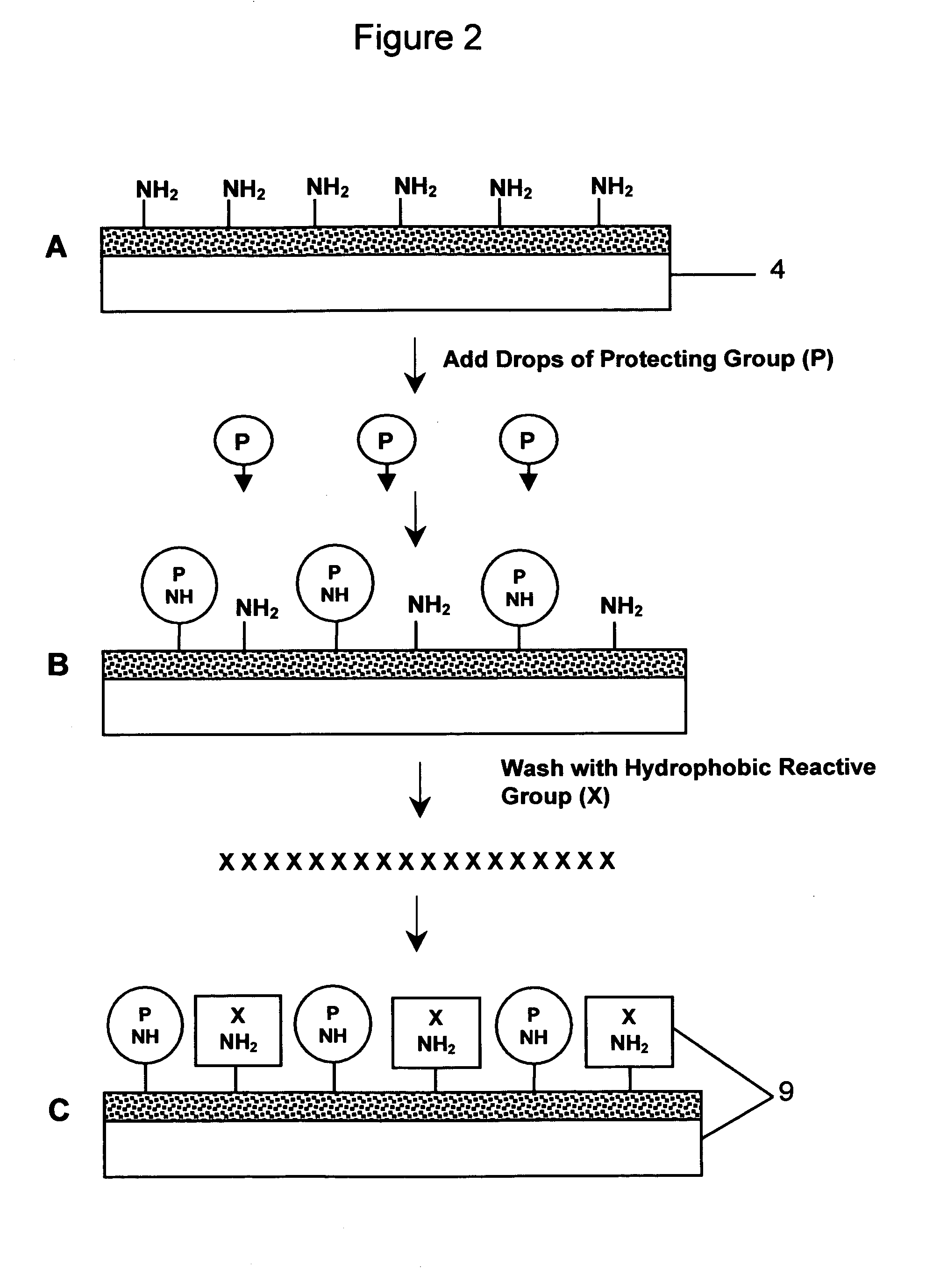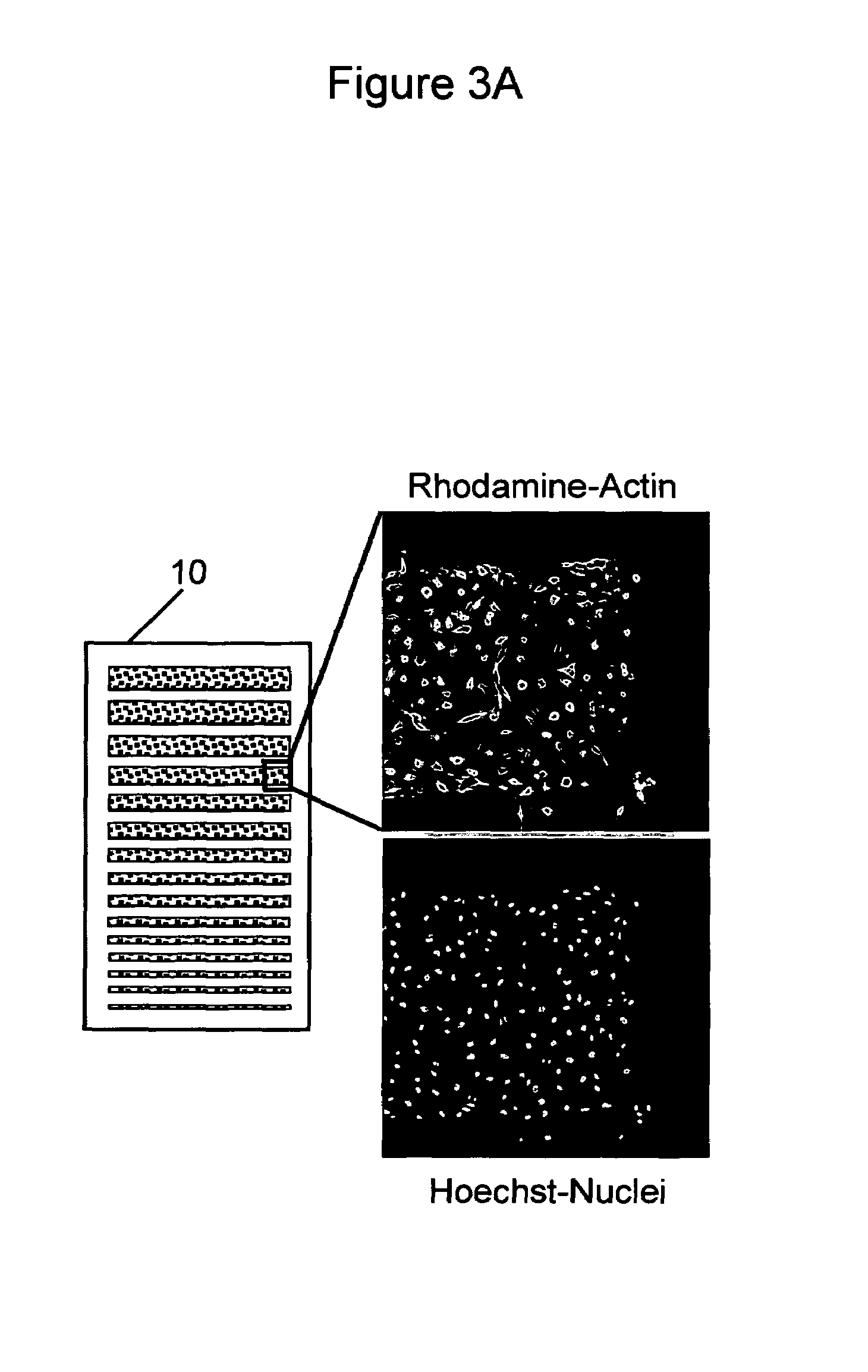Miniaturized cell array methods and apparatus for cell-based screening
a cell array and cell technology, applied in material analysis, positive displacement liquid engine, optical radiation measurement, etc., can solve the problems of increasing the time required for and affecting the quality of cell-based screening. , to achieve the effect of high throughput and high biological content cell-based screening, reducing the amount of time required
- Summary
- Abstract
- Description
- Claims
- Application Information
AI Technical Summary
Benefits of technology
Problems solved by technology
Method used
Image
Examples
example 1
Coupling of Antibodies to Micro-Array of Multiple Cell Types for the Attachment of Specific Lymphoid Cells
[0171]1. The cell line used was a mouse B cell lymphoma line (A20) that does not express IgM on its surface. A micro-array of multiple cell types was prepared for derivatization by being immersed overnight in 20% sulfuric acid, washed 2–3 times in excess distilled water, rinsed in 0.1M sodium hydroxide and blotted dry. The micro-array of multiple cell types was either used immediately or placed in a clean glass beaker and covered with parafilm for future use.[0172]2. The micro-array of multiple cell types was placed in a 60 mm petri dish, and 3-Aminopropyltrimethoxysilane was layered onto the micro-array of multiple cell types ensuring complete coverage without running over the edges (approximately 0.2 ml for a 22×22 mm non-uniform micro-patterned array of cells, and approximately 0.5 ml for a 22×40 mm non-uniform micro-patterned array of cells). After 4 minutes at room temperat...
example 2
High-Content and High Throughput Screen
[0179]The insulin-dependent stimulation of glucose uptake into cells such as adipocytes and myocytes requires a complex orchestration of cytoplasmic processes that result in the translocation of GLUT4 glucose transporters from an intracellular compartment to the plasma membrane. A number of molecular events are triggered by insulin binding to its receptor, including direct signal transduction events and indirect processes such as the cytoskeletal reorganizations required for the translocation process. Because the actin-cytoskeleton plays an important role in cytoplasmic organization, intracellular signaling ions and molecules that regulate this living gel can also be considered as intermediates of GLUT4 translocation.
[0180]A two level screen for insulin mimetics is implemented as follows. Cells carrying a stable chimera of GLUT4 with a Blue Fluorescent Protein (BFP) are arranged on the micro-array of multiple cell types arrays, and then loaded ...
example 3
Improved Cassettes and Enhanced Well Density
[0182]In another aspect, the present invention provides devices and methods for maximizing the cell-plated area and the number of wells that can be imaged in a sub-array, while still obtaining adequate pixel resolution in the image. This result has been achieved through the use of fluidic architectures that minimize the distance and area between wells, thus maximizing well density.
[0183]In one embodiment of this aspect is provided a cassette for cell screening comprising a substrate having a surface, wherein the surface contains a plurality of cell binding locations; a fluid delivery system for delivering reagents to the plurality of cell binding locations, wherein the fluid delivery system comprises a multi-level chamber that mates with the substrate, wherein the multi-level chamber comprises[0184]i. a crossed array of microfluidic input channels and output channels, wherein each well is in fluid connection with one or more input channels...
PUM
| Property | Measurement | Unit |
|---|---|---|
| Volume | aaaaa | aaaaa |
| Volume | aaaaa | aaaaa |
| Volume | aaaaa | aaaaa |
Abstract
Description
Claims
Application Information
 Login to View More
Login to View More - R&D
- Intellectual Property
- Life Sciences
- Materials
- Tech Scout
- Unparalleled Data Quality
- Higher Quality Content
- 60% Fewer Hallucinations
Browse by: Latest US Patents, China's latest patents, Technical Efficacy Thesaurus, Application Domain, Technology Topic, Popular Technical Reports.
© 2025 PatSnap. All rights reserved.Legal|Privacy policy|Modern Slavery Act Transparency Statement|Sitemap|About US| Contact US: help@patsnap.com



